Chesapeake Bay Retriever: Dog Breed Characteristics & Care
Updated on 05/26/24

Unveiling the Chesapeake Bay Retriever: A Comprehensive Guide to Breed Characteristics and Care
Introduction
The Chesapeake Bay Retriever, an American icon, captivates hearts with its distinctive russet-colored coat, unwavering loyalty, and boundless energy. As an avid companion and versatile athlete, this breed exudes an irresistible charm that has endeared it to dog enthusiasts worldwide. In this comprehensive guide, we embark on a journey to explore the unique characteristics and meticulous care requirements of the Chesapeake Bay Retriever. From temperament to training, health to grooming, we delve into every aspect of owning and cherishing this exceptional breed.
Breed Characteristics
* Appearance:
* Medium to large breed, standing 21-24 inches tall and weighing 55-80 pounds
* Distinctive double-coat:
* Outer layer: Wavy, coarse, water-repellent, and ranges from dark brown to a lighter sedge color
* Undercoat: Dense and insulating
* Broad head with a strong muzzle
* Webbed feet and otter tail for enhanced swimming ability
* Temperament:
* Intelligent, eager to please, and unwavering loyalty
* Affectionate with family, but can be reserved with strangers
* Strong-willed and independent, requiring firm and consistent training
* Good with children, exhibiting patience and protectiveness
* Activity Level:
* Extremely active and athletic, requiring ample exercise and mental stimulation
* Thrives on swimming, retrieving, and other water-based activities
* Excellent agility and endurance
Care Guide
* Feeding:
* High-quality diet tailored to the breed's size, activity level, and age
* Daily food intake should be divided into two or three meals
* Monitor weight and adjust portions as needed
* Exercise:
* Daily exercise is essential for physical and mental well-being
* Provide at least 60 minutes of vigorous activity, such as swimming, running, or fetching
* Engage in interactive games and provide ample opportunities for mental stimulation
* Grooming:
* Brush coat regularly to remove loose hair and prevent mats
* Bathe as needed, using a gentle shampoo
* Trim nails regularly to prevent overgrowth
* Health:
* Generally healthy breed, but prone to certain health conditions, including:
* Hip dysplasia
* Elbow dysplasia
* Bloat (gastric dilatation-volvulus)
* Regular veterinary check-ups and preventive care are crucial
* Training:
* Early socialization and obedience training are essential
* Use positive reinforcement and consistency
* Provide ample opportunities for retrieving and swimming activities
Examples of Breed Characteristics and Care in Action
* The Chesapeake Bay Retriever's webbed feet and otter tail allow it to swim with effortless grace and endurance, making it an exceptional waterfowl hunting companion.
* The breed's loyalty and protectiveness extend beyond its family, as evidenced by its service in search and rescue operations and as therapy dogs.
* Regular exercise and mental stimulation are imperative for the Chesapeake Bay Retriever's well-being. A daily swimming session or a challenging agility course provides both physical and cognitive enrichment.
* Proper grooming, including regular brushing and nail trimming, helps maintain the breed's healthy and attractive coat.
* Monitoring the breed's weight and adjusting portions as needed is crucial to prevent obesity, which can lead to health complications.
Conclusion
The Chesapeake Bay Retriever is a multifaceted breed that embodies intelligence, loyalty, and unwavering energy. As a water-loving companion and athletic powerhouse, it demands a lifestyle that aligns with its boundless spirit. By understanding its unique characteristics and meticulously tending to its care needs, owners embark on an exceptional journey with a dog that will forever hold a cherished place in their hearts.
Explore More Pets

Basic Training
Puppy and Baby Introductions

Working Dog Breeds
All About Search and Rescue Dogs

Dog Treatments
Puppy Vaginitis: Signs, Causes and Treatment

Dog Adoption
After More Than 1,200 Days in the Shelter, Coco Goes Home

Basic Training
How to Train Your Puppy to Go on Potty Pads

Hybrid Dog Breeds
The Difference Between a Mutt, Mixed Breed, or Designer Dog?

Dog Treatments
Nail Problems in Dogs

Puppies
7 Reasons Why Two Dogs Are Better Than One
